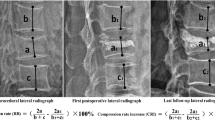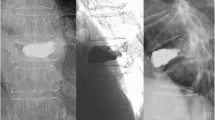Abstract
Refracture of cemented vertebrae is often seen after percutaneous vertebroplasty. The purpose of this prospective study was to evaluate pre-procedural magnetic resonance images (MRI) for the prediction of further collapse and vertebral height loss after vertebroplasty. This study included 81 consecutive patients (73 women and 8 men) with osteoporotic compression fractures. MR studies were performed 1–5 days before vertebroplasty. Patients were followed to evaluate refracture for a minimum of 6 months after treatment. Cox proportional hazards model was used to evaluate relationships between clinical data, covariates on pre-procedural MRI, and the presence of cemented vertebrae refracture. The mean refracture rate was estimated with the Kaplan–Meier method. After a mean follow-up of 23.0 ± 8.2 months, 46 cemented vertebrae (57%) experienced refracture, and the mean loss of anterior vertebral height was 11.3%. The 1-year refracture rate after vertebroplasty was 7%, and rapid increased to 76% in the third year. Cox proportional analysis showed that any 1% decrease in signal intensity on T2-weighted images of the injured vertebra will increase the refracture rate by 0.74% (OR = 0.26, 95% CI 0.08–0.81, p = 0.02), and a 1% increase in the poorly enhanced volume ratio will increase the refracture rate by 4.3% (OR = 5.32, 95% CI 1.22–23.14, p = 0.03). Quantitative pre-procedural MRI appears to be useful in exploring vertebrae with poor bone marrow integrity, which effectively predicts the subsequent refracture of cemented vertebra.



Similar content being viewed by others
References
Jensen ME, Evans AJ, Mathis JM, Kallmes DF, Cloft HJ, Dion JE (1997) Percutaneous polymethylmethacrylate vertebroplasty in the treatment of osteoporotic vertebral body compression fractures: technical aspects. AJNR Am J Neuroradiol 18:1897–1904
Buchbinder R, Osborne RH, Ebeling PR, Wark JD, Mitchell P, Wriedt C, Graves S, Staples MP, Murphy B (2009) A randomized trial of vertebroplasty for painful osteoporotic vertebral fractures. N Engl J Med 361:557–568
Kallmes DF, Comstock BA, Heagerty PJ, Turner JA, Wilson DJ, Diamond TH, Edwards R, Gray LA, Stout L, Owen S, Hollingworth W, Ghdoke B, Annesley-Williams DJ, Ralston SH, Jarvik JG (2009) A randomized trial of vertebroplasty for osteoporotic spinal fractures. N Engl J Med 361:569–579
Belkoff SM, Mathis JM, Jasper LE, Deramond H (2001) The biomechanics of vertebroplasty. The effect of cement volume on mechanical behavior. Spine 26:1537–1541
Hiwatashi A, Moritani T, Numaguchi Y, Westesson PL (2003) Increase in vertebral body height after vertebroplasty. AJNR Am J Neuroradiol 24:185–189
Teng MM, Wei CJ, Wei LC, Luo CB, Lirng JF, Chang FC, Liu CL, Chang CY (2003) Kyphosis correction and height restoration effects of percutaneous vertebroplasty. AJNR Am J Neuroradiol 24:1893–1900
Garfin SR, Yuan HA, Reiley MA (2001) New technologies in spine: kyphoplasty and vertebroplasty for the treatment of painful osteoporotic compression fractures. Spine 26:1511–1515
Trout AT, Kallmes DF, Lane JI, Layton KF, Marx WF (2006) Subsequent vertebral fractures after vertebroplasty: association with intraosseous clefts. AJNR Am J Neuroradiol 27:1586–1591
Lin WC, Lee YC, Lee CH, Kuo YL, Cheng YF, Lui CC, Cheng TT (2008) Refractures in cemented vertebrae after percutaneous vertebroplasty: a retrospective analysis. Eur Spine J 17:592–599
Lin WC, Cheng TT, Lee YC, Wang TN, Cheng YF, Lui CC, Yu CY (2008) New vertebral osteoporotic compression fractures after percutaneous vertebroplasty: retrospective analysis of risk factors. J Vasc Interv Radiol 19:225–231
Kim SH, Kang HS, Choi JA, Ahn JM (2004) Risk factors of new compression fractures in adjacent vertebrae after percutaneous vertebroplasty. Acta Radiol 45:440–445
Do HM (2000) Magnetic resonance imaging in the evaluation of patients for percutaneous vertebroplasty. Top Magn Reson Imaging 11:235–244
Stallmeyer MJ, Zoarski GH, Obuchowski AM (2003) Optimizing patient selection in percutaneous vertebroplasty. J Vasc Interv Radiol 14:683–696
Dansie DM, Luetmer PH, Lane JI, Thielen KR, Wald JT, Kallmes DF (2005) MRI findings after successful vertebroplasty. AJNR Am J Neuroradiol 26:1595–1600
Oka M, Matsusako M, Kobayashi N, Uemura A, Numaguchi Y (2005) Intravertebral cleft sign on fat-suppressed contrast-enhanced MR: correlation with cement distribution pattern on percutaneous vertebroplasty. Acad Radiol 12:992–999
Tanigawa N, Komemushi A, Kariya S, Kojima H, Shomura Y, Ikeda K, Omura N, Murakami T, Sawada S (2006) Percutaneous vertebroplasty: relationship between vertebral body bone marrow edema pattern on MR images and initial clinical response. Radiology 239:195–200
Cotten A, Boutry N, Cortet B, Assaker R, Demondion X, Leblond D, Chastanet P, Duquesnoy B, Deramond H (1998) Percutaneous vertebroplasty: state of the art. Radiographics 18:311–320 (discussion 320–313)
Gaughen JR Jr, Jensen ME, Schweickert PA, Marx WF, Kallmes DF (2002) The therapeutic benefit of repeat percutaneous vertebroplasty at previously treated vertebral levels. AJNR Am J Neuroradiol 23:1657–1661
Lin CC, Chen IH, Yu TC, Chen A, Yen PS (2007) New symptomatic compression fracture after percutaneous vertebroplasty at the thoracolumbar junction. AJNR Am J Neuroradiol 28:1042–1045
Ahn Y, Lee JH, Lee HY, Lee SH, Keem SH (2008) Predictive factors for subsequent vertebral fracture after percutaneous vertebroplasty. J Neurosurg Spine 9:129–136
Lee WS, Sung KH, Jeong HT, Sung YS, Hyun YI, Choi JY, Lee KS, Ok CS, Choi YW (2006) Risk factors of developing new symptomatic vertebral compression fractures after percutaneous vertebroplasty in osteoporotic patients. Eur Spine J 15:1777–1783
Hiwatashi A, Yoshiura T, Yamashita K, Kamano H, Dashjamts T, Honda H (2009) Subsequent fracture after percutaneous vertebroplasty can be predicted on preoperative multidetector row CT. AJNR Am J Neuroradiol 30:1830–1834
Kumpan W, Salomonowitz E, Seidl G, Wittich GR (1986) The intravertebral vacuum phenomenon. Skelet Radiol 15:444–447
Stäbler A, Schneider P, Link TM, Schöps P, Springer OS, Dürr HR, Reiser M (1999) Intravertebral vacuum phenomenon following fractures: CT study on frequency and etiology. J Comput Assist Tomogr 23:976–980
Lane JI, Maus TP, Wald JT, Thielen KR, Bobra S, Luetmer PH (2002) Intravertebral clefts opacified during vertebroplasty: pathogenesis, technical implications, and prognostic significance. AJNR Am J Neuroradiol 23:1642–1646
Peh WC, Gelbart MS, Gilula LA, Peck DD (2003) Percutaneous vertebroplasty: treatment of painful vertebral compression fractures with intraosseous vacuum phenomena. AJR Am J Roentgenol 180:1411–1417
Kanchiku T, Taguchi T, Toyoda K, Fujii K, Kawai S (2003) Dynamic contrast-enhanced magnetic resonance imaging of osteoporotic vertebral fracture. Spine 28:2522–2526 (discussion 2522)
Naul LG, Peet GJ, Maupin WB (1989) Avascular necrosis of the vertebral body: MR imaging. Radiology 172:219–222
Baur A, Stäbler A, Brüning R, Bartl R, Krödel A, Reiser M, Deimling M (1998) Diffusion-weighted MR imaging of bone marrow: differentiation of benign versus pathologic compression fractures. Radiology 207:349–356
Ito Y, Hasegawa Y, Toda K, Nakahara S (2002) Pathogenesis and diagnosis of delayed vertebral collapse resulting from osteoporotic spinal fracture. Spine J 2:101–106
Uemura A, Kobayashi N, Numaguchi Y, Fuwa S, Saida Y (2007) Preprocedural MR imaging for percutaneous vertebroplasty: special interest in contrast enhancement. Radiat Med 25:325–328
Diamond TH, Clark WA, Kumar SV (2007) Histomorphometric analysis of fracture healing cascade in acute osteoporotic vertebral body fractures. Bone 40:775–780
Cho T, Matsuda M, Sakurai M (1996) MRI findings on healing process of vertebral fracture in osteoporosis. J Orthop Sci 1:16–33
Acknowledgments
This work was partly supported by grants from Chang Gung Memorial Hospital (Chang Gung Medical Research Project; CMRPG860101 to C.-C. Lui).
Conflict of interest statement
None.
Author information
Authors and Affiliations
Corresponding author
Rights and permissions
About this article
Cite this article
Lin, WC., Lu, CH., Chen, HL. et al. The impact of preoperative magnetic resonance images on outcome of cemented vertebrae. Eur Spine J 19, 1899–1906 (2010). https://doi.org/10.1007/s00586-010-1434-6
Received:
Revised:
Accepted:
Published:
Issue Date:
DOI: https://doi.org/10.1007/s00586-010-1434-6




